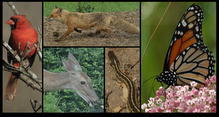Fox Returns Sick with Mange







Help! There's a fox outside during the day. What do I do?
Do you observe any of these behaviors?
>It is scratching, chewing or licking its skin.
>It has open sores or wounds.
>It has a bare tail, squinty eyes and/or a crusty film over mouth, eyes and nose.
>It moves slowly and often lies in one place for a long period of time.
>It appears thin, ragged and malnourished.
>It walks very slowly with stiff movements of hind legs.
>It is searching for food in daylight and close to humans and does not seem afraid.
Fact and Fiction about Foxes with Mange:
It is very common for individuals to believe that if they see a fox near their homes, looking or acting sick, that it must have rabies. 99% of the time this is not the case. The animal most likely is suffering from mange; a debilitating condition that causes severe scratching, open sores and loss of hair. The good news is that it is easily treatable.
Information to help you understand an animal with mange
>A fox with mange is very weak from an inability to hunt for food.
>They are tired and suffering from constant itching and burning sensations.
>Because they must eat they will venture close to homes looking for food. Pet food that is left outside is a frequent choice.
>The fox will not attack cats, dogs or children. Even under normal circumstances it is not aggressive. It will react however, if trying to be captured.
>They do not want to take up residence in your area permanently. If treated and allowed to recover they will move on.
What can you do?
>Stay calm and remember you are not in an unsafe situation.
>Call the Wildlife Rescue League at 703-440-0800. You will be put into contact with someone that can give you more information to handle your situation.
>Don’t attempt to capture the animal.
>Provide food and water for the animal - preferably in a safe quiet area.
>If being treated for mange, allow the fox to rest and heal in a place where you can monitor progress.
>Keep information available for neighbors that have questions or concerns.













